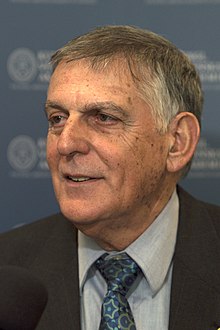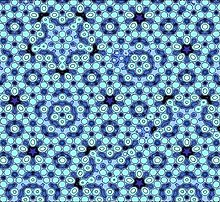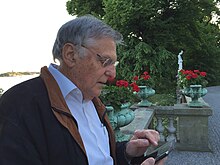Dan Shechtman
Dan Shechtman דן שכטמן | |
|---|---|
 Dan Shechtman, Nobel Prize 2011 press conference. | |
| Born | January 24, 1941 |
| Education | Technion – Israel Institute of Technology |
| Alma mater | Technion |
| Known for | Quasicrystals |
| Spouse | Tzipora Shechtman |
| Awards | Weizmann Prize(1993) Israel Prize (1998) Wolf Prize in Physics (1999) Gregori Aminoff Prize (2000) Nobel Prize in Chemistry (2011) |
| Scientific career | |
| Fields | Materials science |
| Institutions | Wright-Patterson Air Force Base Johns Hopkins University National Institute of Standards and Technology Iowa State University Technion Tohoku University |
Dan Shechtman (Hebrew: דן שכטמן; born January 24, 1941)[1] is the Philip Tobias Professor of Materials Science at the Technion – Israel Institute of Technology, an Associate of the US Department of Energy's Ames National Laboratory, and Professor of Materials Science at Iowa State University. On April 8, 1982, while on sabbatical at the U.S. National Bureau of Standards in Washington, D.C., Shechtman discovered the icosahedral phase, which opened the new field of quasiperiodic crystals.[2]
He was awarded the 2011 Nobel Prize in Chemistry for the discovery of quasicrystals, making him one of six Israelis who have won the Nobel Prize in Chemistry.[3][4]
Biography[edit]
Dan Shechtman was born in 1941 in Tel Aviv, in what was then Mandatory Palestine; the city became part of the new state of Israel in 1948. He grew up in Petah Tikva and Ramat Gan in a Jewish family.[5] His grandparents had immigrated to Palestine during the Second Aliyah (1904–1914) and founded a printing house. As a child Shechtman was fascinated by Jules Verne's The Mysterious Island (1874), which he read many times. His childhood dream was to become an engineer like the main protagonist, Cyrus Smith.
I thought that was the best thing a person could do. The engineer in the book knows mechanics and physics, and he creates a whole way of life on the island out of nothing. I wanted to be like that.
— Dan Shechtman[6]
Shechtman is married to Prof. Tzipora Shechtman, Head of the Department of Counseling and Human Development at Haifa University, and author of two books on psychotherapy.[7][8] They have a son Yoav Shechtman (a postdoctoral researcher in the lab of W. E. Moerner) and three daughters: Tamar Finkelstein (an organizational psychologist at the Israeli police leadership center), Ella Shechtman-Cory (a PhD in clinical psychology), and Ruth Dougoud-Nevo (also a PhD in clinical psychology).[9][10]
Academic career[edit]

After receiving his Ph.D. in Materials Engineering from the Technion in 1972, where he also obtained his B.Sc. in Mechanical Engineering in 1966 and M.Sc. in Materials Engineering in 1968,[1] Shechtman was an NRC fellow at the Aerospace Research Laboratories at Wright Patterson AFB, Ohio, where he studied for three years the microstructure and physical metallurgy of titanium aluminides. In 1975, he joined the department of materials engineering at Technion. In 1981–1983 he was on sabbatical at Johns Hopkins University, where he studied rapidly solidified aluminum transition metal alloys, in a joint program with NBS. During this study he discovered the icosahedral phase which opened the new field of quasiperiodic crystals.
In 1992–1994 he was on sabbatical at National Institute of Standards and Technology (NIST), where he studied the effect of the defect structure of CVD diamond on its growth and properties. Shechtman's Technion research is conducted in the Louis Edelstein Center, and in the Wolfson Centre which is headed by him. He served on several Technion Senate Committees and headed one of them.
Shechtman joined the Iowa State faculty in 2004. He currently spends about five months a year in Ames on a part-time appointment.[3][11]
Since 2014 he has been the head of the International Scientific Council of Tomsk Polytechnic University.[12]
Work on quasicrystals[edit]

From the day Shechtman published his findings on quasicrystals in 1984 to the day Linus Pauling died in 1994, Shechtman experienced hostility from him toward the non-periodic interpretation. "For a long time it was me against the world," he said. "I was a subject of ridicule and lectures about the basics of crystallography. The leader of the opposition to my findings was the two-time Nobel Laureate Linus Pauling, the idol of the American Chemical Society and one of the most famous scientists in the world. For years, 'til his last day, he fought against quasi-periodicity in crystals. He was wrong, and after a while, I enjoyed every moment of this scientific battle, knowing that he was wrong."[14]
Linus Pauling is noted saying "There is no such thing as quasicrystals, only quasi-scientists."[15] Pauling was apparently unaware of a paper in 1981 by H. Kleinert and K. Maki which had pointed out the possibility of a non-periodic Icosahedral Phase in quasicrystals[16] (see the historical notes). The head of Shechtman's research group told him to "go back and read the textbook" and a couple of days later "asked him to leave for 'bringing disgrace' on the team."[17] Shechtman felt rejected.[15] On publication of his paper, other scientists began to confirm and accept empirical findings of the existence of quasicrystals.[18][19]
The Nobel Committee at the Royal Swedish Academy of Sciences said that "his discovery was extremely controversial," but that his work "eventually forced scientists to reconsider their conception of the very nature of matter."[15] Through Shechtman's discovery, several other groups were able to form similar quasicrystals by 1987, finding these materials to have low thermal and electrical conductivity, while possessing high structural stability.[20][21][22] Quasicrystals have also been found naturally.[23][24]
A quasiperiodic crystal, or, in short, quasicrystal, is a structure that is ordered but not periodic. A quasicrystalline pattern can continuously fill all available space, but it lacks translational symmetry.[25] "Aperiodic mosaics, such as those found in the medieval Islamic mosaics of the Alhambra palace in Spain and the Darb-i Imam shrine in Iran, have helped scientists understand what quasicrystals look like at the atomic level. In those mosaics, as in quasicrystals, the patterns are regular – they follow mathematical rules – but they never repeat themselves."[15]"An intriguing feature of such patterns, [which are] also found in Arab mosaics, is that the mathematical constant known as the Greek letters phi or tau, or the "golden ratio", occurs over and over again. Underlying it is a sequence worked out by Fibonacci in the 13th century, where each number is the sum of the preceding two."[15]
Quasicrystalline materials could be[needs update] used in a large number of applications, including the formation of durable steel used for fine instrumentation, and non-stick insulation for electrical wires and cooking equipment.,[26][27] but presently have no technological applications.
The Nobel prize was 10 million Swedish krona (approximately US$1.5 million).[15]
Presidential bid[edit]
On January 17, 2014, in an interview with Israel's Channel One, Shechtman announced his candidacy for President of Israel.[28] Shechtman received the endorsement of the ten Members of Knesset required to run. In the elections, held on June 10, 2014, he was awarded only one vote. This led Israeli press and Israeli humorists to qualify Shechtman as "quasi-president" in reference to the "quasi-scientist" quote.
Awards[edit]

- 2019 Honorary John von Neumann Professor title [29]
- 2014 Fray International Sustainability Award, SIPS 2014 [30]
- 2013 Honorary doctorate from Bar-Ilan University[31]
- 2011 Nobel Prize in Chemistry for the discovery of quasicrystals
- 2008 European Materials Research Society (E-MRS) 25th Anniversary Award
- 2002 EMET Prize in Chemistry
- 2000 Muriel & David Jacknow Technion Award for Excellence in Teaching
- 2000 Gregori Aminoff Prize of the Royal Swedish Academy of Sciences
- 1999 Wolf Prize in Physics.[32]
- 1998 Israel Prize, for Physics.[33]
- 1993 Weizmann Science Award[34]
- 1990 Rothschild Prize in Engineering[35]
- 1988 New England Academic Award of the Technion[citation needed]
- 1988 International Award for New Materials[citation needed] of the American Physical Society
- 1986 Physics Award of the Friedenberg Fund for the Advancement of Science and Education[citation needed]
Published works[edit]
- Shechtman, D.; Blech, I.; Gratias, D.; Cahn, J.W. (1984). "Metallic Phase with Long-Range Orientational Order and No Translational Symmetry". Physical Review Letters. 53 (20): 1951. Bibcode:1984PhRvL..53.1951S. doi:10.1103/PhysRevLett.53.1951.
- Swartzendruber, L.; Shechtman, D.; Bendersky, L.; Cahn, J.W. (1985). "Nuclear γ-ray resonance observations in an aluminum-based icosahedral quasicrystal". Physical Review B. 32 (2): 1383–1385. Bibcode:1985PhRvB..32.1383S. doi:10.1103/PhysRevB.32.1383. PMID 9937171.
- Cahn, John W.; Gratias, Denis; Shechtman, Dan (1986). "Pauling's model not universally accepted". Nature. 319 (6049): 102. Bibcode:1986Natur.319..102C. doi:10.1038/319102a0. S2CID 4372556.
- Shechtman, Dan (1988). "The Icosahedral Quasiperiodic Phase". Physica Scripta. T23: 49. Bibcode:1988PhST...23...49S. doi:10.1088/0031-8949/1988/T23/008. S2CID 250844166.
- Cahn, John W.; Shechtman, Dan; Gratias, Denis (1986). "Indexing of icosahedral quasiperiodic crystals". Journal of Materials Research. 1 (1): 13. Bibcode:1986JMatR...1...13C. doi:10.1557/JMR.1986.0013. S2CID 138068389.
See also[edit]
- List of Israel Prize recipients
- List of Israeli Nobel laureates
- List of Jewish Nobel laureates
- Science and technology in Israel
References[edit]
- ^ a b Dan Shechtman Archived November 10, 2011, at the Wayback Machine. (PDF). Retrieved on January 28, 2012.
- ^ "Israeli Wins Chemistry Nobel For Quasicrystals". npr.org. Retrieved October 5, 2011.
- ^ a b Iowa State, Ames Laboratory, Technion Scientist Wins Nobel Prize in Chemistry. Newswise.com (October 5, 2011). Retrieved on January 28, 2012.
- ^ Multiple sources:
- Tiny Israel a Nobel heavyweight, especially in chemistry Times of Israel
- Israel’s Shechtman vindicated with Nobel for chemistry AFP (in Al Arabiya News) Thursday, October 6, 2011
- Fiske, Gavriel (October 9, 2013). "Tiny Israel a Nobel heavyweight, especially in chemistry". Times of Israel. Retrieved October 13, 2013.
- ^ JINFO. "Jewish Nobel Prize Winners in Chemistry". www.jinfo.org. Retrieved March 30, 2023.
- ^ "Clear as crystal". Haaretz. April 1, 2011. Retrieved October 6, 2011.
- ^ Professor Zipora Shechtman Archived April 1, 2012, at the Wayback Machine. Edu.haifa.ac.il. Retrieved on January 28, 2012.
- ^ He deserves it, wife of 2011 Nobel Chemistry laureate says Archived October 26, 2011, at the Wayback Machine. Monstersandcritics.com (October 5, 2011). Retrieved on January 28, 2012.
- ^ Shechtman Wins Chemistry Nobel for Crystal Find Archived December 18, 2011, at the Wayback Machine. Mobile.bloomberg.com (October 5, 2011). Retrieved on January 28, 2012.
- ^ Genealogy of the Shechtman family. Geni.com (August 12, 2010). Retrieved on January 28, 2012.
- ^ Iowa State prof wins Nobel in chemistry (Chicago Tribune, October 5, 2011)
- ^ "В ТПУ впервые прошло заседание Международного научного совета". Archived from the original on September 3, 2014. Retrieved September 1, 2014.
- ^ Ünal, B; V. Fournée; K.J. Schnitzenbaumer; C. Ghosh; C.J. Jenks; A.R. Ross; T.A. Lograsso; J.W. Evans; P.A. Thiel (2007). "Nucleation and growth of Ag islands on fivefold Al-Pd-Mn quasicrystal surfaces: Dependence of island density on temperature and flux" (PDF). Physical Review B. 75 (6): 064205. Bibcode:2007PhRvB..75f4205U. doi:10.1103/PhysRevB.75.064205. S2CID 53382207.
- ^ "Iowa State, Ames Laboratory, Technion scientist wins Nobel Prize in Chemistry" (Press release). Ames, Iowa: Iowa State University. October 5, 2011.
- ^ a b c d e f Lannin, Patrick (October 5, 2011). "Ridiculed crystal work wins Nobel for Israeli". Reuters. Retrieved October 22, 2011.
- ^ Kleinert H., Maki K. (1981). "Lattice Textures in Cholesteric Liquid Crystals" (PDF). Fortschritte der Physik. 29 (5): 219–259. Bibcode:1981ForPh..29..219K. doi:10.1002/prop.19810290503.
- ^ Jha, Alok (January 5, 2013). "Dan Shechtman: 'Linus Pauling said I was talking nonsense'". Guardian.
- ^ Bradley, David (October 5, 2011). "Dan Shechtman discusses quasicrystals". ScienceBase. Retrieved October 5, 2011. Shechtman video interview
- ^ "Clear as crystal". Haaretz. April 1, 2011. Retrieved October 6, 2011.
- ^ Day, Charles (February 1, 2001). "Binary Quasicrystals Discovered That Are Stable and Icosahedral". Physics Today. 54 (2): 17–18. Bibcode:2001PhT....54b..17D. doi:10.1063/1.1359699. ISSN 0031-9228.
- ^ Wang, N.; Chen, H.; Kuo, K. H. (August 31, 1987). "Two-dimensional quasicrystal with eightfold rotational symmetry". Physical Review Letters. 59 (9): 1010–1013. Bibcode:1987PhRvL..59.1010W. doi:10.1103/PhysRevLett.59.1010. PMID 10035936.
- ^ Bancel, Peter A.; Heiney, Paul A. (June 15, 1986). "Icosahedral aluminum--transition-metal alloys". Physical Review B. 33 (12): 7917–7922. Bibcode:1986PhRvB..33.7917B. doi:10.1103/PhysRevB.33.7917. PMID 9938181.
- ^ Crane, Leah (December 8, 2016). "Third-ever natural quasicrystal found in Siberian meteorite". New Scientist. Retrieved January 28, 2022.
- ^ Bindi, Luca; Eiler, John M.; Guan, Yunbin; Hollister, Lincoln S.; MacPherson, Glenn; Steinhardt, Paul J.; Yao, Nan (January 31, 2012). "Evidence for the extraterrestrial origin of a natural quasicrystal". Proceedings of the National Academy of Sciences. 109 (5): 1396–1401. doi:10.1073/pnas.1111115109. ISSN 0027-8424. PMC 3277151. PMID 22215583.
- ^ Janot, Christian (1997). Quasicrystals – a primer, 2nd ed. Oxford University Publishing. ISBN 0-19-856551-8.
- ^ Van Noorden, Richard (October 5, 2011). "Impossible crystals snag chemistry Nobel". nature. doi:10.1038/news.2011.572. Retrieved October 5, 2011.
- ^ Carpenter, Jennifer (October 5, 2011). "Nobel win for crystal discovery". BBC. Retrieved October 5, 2011.
- ^ "Nobel Prize winning professor announces run for president of Israel".
- ^ Recipients are listed on Budapest University of Technology and Economics website: "John von Neumann Professors". Budapest University of Technology and Economics. Archived from the original on September 12, 2022. Retrieved September 12, 2022.
- ^ "Dan Shechtman Winner of the Fray Award". www.flogen.org.
- ^ "Honorary Doctorate Recipients, Bar-Ilan University". Archived from the original on May 24, 2017. Retrieved September 3, 2019.
- ^ "Wolf Prize Recipients in Physics". Wolffund.org.il. Archived from the original on October 2, 2006. Retrieved October 5, 2011.
- ^ "Israel Prize Official Site – Recipients in 1998 (in Hebrew)". Archived from the original on October 6, 2014.
- ^ "פרס ויצמן למדעים מדויקים יוענק לפרופ' מיקי אלעד – Technion – Israel Institute of Technology". Technion – Israel Institute of Technology – (in Hebrew). July 26, 2021. Retrieved May 5, 2022.
- ^ Ziv, Jacob (2010). "Engineering". Rothschild Prizes 2010: Fifty Years (PDF). Jerusalem. pp. 26, 32.
{{cite book}}: CS1 maint: location missing publisher (link)
Further reading[edit]
- D. P. DiVincenzo and P. J. Steinhardt, eds. 1991. Quasicrystals: The State of the Art. Directions in Condensed Matter Physics, Vol 11. ISBN 981-02-0522-8.
- T. Janssen. 2007. Quasicrystals: Comparative dynamics. Nature Materials, Vol 6., 925–926.
External links[edit]
- Dan Shechtman on Nobelprize.org
- Nobel Laureates from Technion – Israel Institute of Technology.
- Story of quasicrystals as told by Shechtman to APS News in 2002.
- Biography/CV Page – Technion
- TechnionLIVE e-newsletter Archived November 25, 2015, at the Wayback Machine
- Dan Shechtman (Iowa State faculty page)
- 2012 interview with The Times of Israel
- 1941 births
- Nobel laureates in Chemistry
- Israeli Nobel laureates
- Crystallographers
- Iowa State University faculty
- Israel Prize in physics recipients
- Israeli chemists
- Israeli Jews
- Israeli atheists
- Israeli materials scientists
- Israeli physicists
- Jewish atheists
- Jewish chemists
- Jewish physicists
- Palestinian people
- Living people
- Members of the European Academy of Sciences and Arts
- Members of the Israel Academy of Sciences and Humanities
- Members of the United States National Academy of Engineering
- Foreign Members of the Russian Academy of Sciences
- EMET Prize recipients in the Exact Sciences
- Scientists from Tel Aviv
- Technion – Israel Institute of Technology alumni
- Academic staff of Technion – Israel Institute of Technology
- Wolf Prize in Physics laureates
- Candidates for President of Israel
- Quasicrystals
- Weizmann Prize recipients

